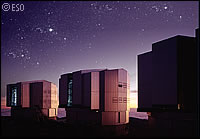Further evidence of a giant black hole in our galaxy discovered by European astronomers
An international team of astronomers, including groups from Germany and France, have observed an otherwise normal star orbiting what they believe to be a supermassive black hole at the centre of the Milky Way Galaxy. Most astronomers believe that quasars, the most luminous objects in our universe, are evidence of the existence of a black hole. Ever since the discovery at the centre of our galaxy of a dense cluster of stars concentrated around an unusually large quasar source, researchers have speculated that there is a giant black hole at the centre of the Milky Way. But difficulties in mapping the gravitational field of this area have made it unwise to exclude other explanations. But when the project team, under the coordination of the Max-Planck Institute in Germany, used the new NAOS-CONICA (NACO) telescope in Chile to study the phenomenon, they were amazed at the results. 'The first observations this year with NACO gave us right away the sharpest and 'deepest' images of the Milky Way Centre ever taken,' said Andreas Eckart of the University of Cologne. Another member of the team, Tomas Ott from the Max-Planck Institute, explains: 'When we included the latest NACO data in our analysis, we could not believe our eyes. The star S2, which is currently closest [to the central quasar source], had just performed a rapid swing-by. We realised that we were witnessing the motion of a star in orbit around a central black hole.' No event like this has ever been recorded. The data proves that the S2 is orbiting the central black hole just as the Earth orbits the Sun, but nearly 200 times faster. And there now seems little or no doubt that at the centre of this event lies one massive black hole, rather than a cluster of stellar size black holes or neutron stars. The only other viable explanation would be the existence of a hypothetical 'boson star' made up of heavy elementary particles. But, as Reinhard Genzel explains, 'even if such a boson star is in principal possible, it would rapidly collapse into a supermassive black hole anyhow, so I think we have pretty much clinched the case.' The next challenge for astrologers is to try and understand when and how these supermassive black holes formed and why almost every massive galaxy appears to contain one. It is hoped that upcoming observations with instruments at the VLT Interferometer and the Large Binocular Telescope will result in the next breakthrough in this exciting field of research.



